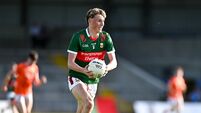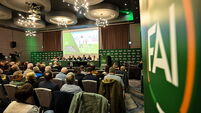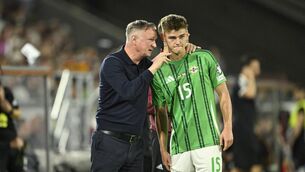New pretenders to hurling throne are circling the wagons
Five cycles ago in the infancy of World War I, Clare, not seen again until 1995, did battle with Laois for the All-Ireland title. Clare were captained by Amby Power who had given a great display.
According to match reports “the major portion of the honours fall” to the captain “who evinced form which I do not remember seeing bettered”.
The correspondent known as ‘The Carp’ claimed there was nothing between the teams except for one area of the field. He is scathing in his criticism of the Laois defence.
“The defence and custodian were painfully slow and seemed to be the last persons in Croke Park to realise what was occurring until the green flag was waved”.
One club in Laois, Monadrehid, refused to make any financial contribution to the county fund for the All-Ireland as was the norm.
They claimed that they couldn’t subscribe as they were paying an injured player ten shillings a week, a tidy sum in those days, in lieu of lost wages because of an injury in a club game.
So even 100 years ago player welfare issues were important at local level.
Laois, captained by Jack Finlay, bounced back in 1915, their last appearance, defeating Cork. The following year it was the old reliables as Tipperary took on Kilkenny in the final.
In the 1930s the cycle kicked in again. The great Limerick team, powered by the famous Mackeys from Ahane, appeared in four All-Irelands from ’33, winning two. The Golden Jubilee of 1934 was an important milestone in GAA history and Limerick defeated Dublin after a replay in front of a crowd of 30,000. Dublin benefited when players from other counties based in the capital declared for them. Limerick were captained by midfielder Timmy Ryan that year while Mick Mackey had the honour in ’36, having been defeated by the Lory Meagher led Kilkenny the previous year.
This team has been acclaimed as the greatest Limerick side ever with many from the county proposing that Mick Mackey was the greatest hurler of all time.
Fans of Cork, Kilkenny and Tipperary recognise Mackey as the greatest of his era but argue for different players as the all-time great. The following year it was Tipperary who prevailed against Kilkenny in Killarney.
Cork beat a Wexford team in ’54 in front of almost 85,000 fans to capture a three in-a-row matching Tipp’s achievement of ’49,’50 and ’51 .
Galway were also in contention for honours, appearing in the finals of ’53, ’55 and ’58 but it was Wexford who captured the imagination of hurling fans the length and breadth of the country. They beat Galway and the following year and famously went on to defeat Cork in the ’56 final denying Christy Ring his ninth All-Ireland medal, in front of 83,000. (The capacity of Croke Park at present is just over 82,000).
Wexford were much admired as a hurling force but as a youngster I always begrudged them their victory in ’56 because of Ring’s record especially as John Doyle had matched it by ’65.
During the fifties Nicky Rackard was the Wexford star in a team of household names which included his brothers Billy and Bobby. He starred on the St Kieran’s Kilkenny school teams as a teenager and he scored 59 championship goals up to his retirement in ’57 at the age of 35.
Moving through the cycle and the ‘70s saw the re-emergence of Limerick in 1973, captained by the speedy Eamonn Grimes and including the Bennis brothers, Hartigans, Eamonn Cregan and Ned Rea.
Kilkenny, the vanquished that day, pointed to their injury problems as mitigating circumstances and bounced back the following year. Galway, powered by John Connolly and half backs Sean Silke and Iggy Clarke turned Cork over in the 1975 semi only to lose the final to Kilkenny. Wexford came strongly to battle for honours in ’76 and ’77 but Cork had their measure.
There’s an exception to every rule.
The eighties had Offaly with two and Galway with three titles. The other five were shared by the big three.
Twenty years ago four new teams emerged. Offaly, Limerick, Wexford and Clare were the counties that fought it out for honours. 1994 saw Offaly come with a late surge, scoring 2-5 in the last five minutes to overhaul a tiring Limerick team.
Little has to be written about Clare’s victories in ’95 and ‘97, the Loughane years, when they were led to victory by current Dublin manager Anthony Daly. Fourteen man Wexford, under Liam Griffin and captained by Martin Storey defeated Limerick in 1996. Kilkenny, Cork and Tipperary were battling for honours in the early years of the nineties but they didn’t feature again until ’99 when Cork defeated Kilkenny.
Since then all the titles have been won by the big three with the Cats winning the lion’s share.
This year history repeats. Provincial champions Dublin and Limerick are centre stage with Clare and Galway in the background. Tipperary (26 titles), finished for 2013 are fading as are Cork. Kilkenny with 34 titles will, most likely, be the only ‘traditional’ county in the semi-finals.
Will history repeat itself again in the middle of this decade with non traditional “new” winners and with the emergence of new stars?












